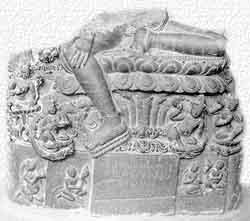
 |
|
|
|
TWO MEDIAEVAL INSCRIPTIONS |
From the journal of the Asiatic Society, Letters, Vol. XIX, No. 1, 1953 |
|
|
|
| The inscription consists of four
lines of writing in north-eastern script of c. 12th century A.D. The
beginnings of almost all the lines are broken with the result that several
words are only in a fragmentary state and cannot be properly understood.
The record is dated in the year 3 of the reign of Madanapala, one of the
last Pala rulers who ruled from 1144-45 A.D. up to 1161-62 A.D. 2
Besides this one, three more inscriptions of the reign of
Madanapala have been noticed. They are (I) the Manahali copperplate3 of
year 8; (2) Jayanagar Image Inscription4
of year 19(?) and a recently acquired stone inscription5
of year 18, Saka year, 1083.
The language of the inscription is incorrect Sanskrit. Its object is to record the dedication of the (Parvati) image by a person called Mamayika. He seems to be described in the inscription as na(na)u-sama-ratha-sa(sa)kti. This expression is not a happy one and might have been used in the place of samana-nau-ratha-sakti denoting probably that the donor was one whose power lay in having possessed naval boats6 and chariots in equally good number. As the epithet would show, Mamayika was perhaps an important personage in the king's service holding command of the royal navy and chariots.
TEXT 7
The rajavali is as before. On the 24th day of the month of Vaisakha in the year 3 of the prosperous and victorious reign of Madanapala this pious gift was made by Mamayika those power lay in having possessed naval boats and chariots in equal Number.
|
|
 |
|
The inscription consists of three lines. It is written in eastern script of c. 12th century A.D. The language is Sanskrit. The object of the epigraph is to record the gift of the image by sadhu Srikara and sadhu Dagonmata2 who were merchants and inhabitants of Mathura. The inscription is dated in year 42 of an era or samvat not specified. It is difficult to say to which era the year should be referred. Palaeographically, the inscription belongs to the Ist part of the 12th century A.D. And as such it might refer to the regnal year 42 of Ramapala. But we cannot be sure on this point as ordinarily the regnal years are referred to after the mention of the king in whose reign the years fall and there is no mention of any king in this particular instance. The term sadhu is significant. The merchants, as generally found, are very devoted and generous as lay-worshippers, and as a result of this they came to have this appellation before their names. In the Markandeya Purana, chapter 68, it is stated that Padmini-vidya ('which is productive of earthly enjoyment (bhogopapadika) land which has for its bases the treasures') (tatsamsraya ye nidhayah) can be attained by good men due to the grace of the goods, and by their own service to the sadhus (devatanam prasadena sadhu-samsevanena ca3 ). This also implies quite naturally that those who would like to enjoy wealth must not only seek divine grace and serve the sadhus, but must themselves be sadhus. Hence the epithet sadhu is very fitting before the names of the merchants who are seekers of wealth. It is interesting to note that the present-day merchant families of Bihar and Bengal are also called Sahu or Sau, a corrupt form of Sanskrit sadhu. The term which was at first used to denote the honesty and integrity of the merchants of businessmen in their secular and religious life came to mean laterly a particular community, analogically.
The gift of an image at Bihar by sadhu Srikara and sadhu Dagonmata, merchants and inhabitants of Mathura indicate (quite naturally of course) the importance of BIhar as a religious centre in the eyes of the Buddhists. There is plenty of literary and epigraphic evidence to show that Buddhists from different parts of India and outside visited Bihar, or made gifts here. They include the well-known names of Chinese travellers, Fa-Hien and Hiuen Tsang; Meghavarna, a contemporary of Samudragupta, Prakh-yatakirti1 (5th century A.D.), Mahanaman2 (6th century A.D.), Udayasri3 (11th century A.D.) of Ceylon; Balaputradeva4 (9th century A.D.), lord of Suvarnadvipa and also a number of individuals from Sindhu-desa, Kausambi, Mathura and other places. TEXT 5 om6 deva(ya)-dha[r]moyam(m) / Danapati-mathura (thura). Vanik sadhu(dhu) Srikara sadhu(dhu) Da- gonmatasya7 sam 42[//] |
|
Research Papers [ 001 - 050 | 051 - 100 | 101 - 150 | 151 - 200 | 201 - 250 ] |
|
[ Resume | Contact Me ] |
| [ Books | Lectures | Education | Experience | Scholarships | Countries visited] |
|
|